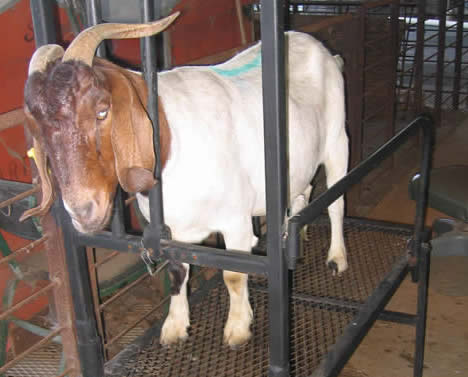

Quality tested semen is available from a number of agricultural institutions , giving farmers a chance of getting good service in the field of AI. Direct importation of semen is also possible for the keen breeder, but can be quite costly for a smallholder farmer especially due to the cost of storage. Goat semen is also commercially available but on small scale.
Imported semen is mainly used by cattle farmers who have pure bred cows and keep them for maximum milk yields or breeding of high quality stock for sale. It is usually more expensive and your local AI provider may not have it readily available.
Management of breeding does
If fed well goats should become ready to breed from the age of 8 months Puberty and the pregnancy period
Puberty in females is defined as the age they first expressed estrus with ovulation. It should not be considered sexual maturity. If animals are bred at puberty, a high percentage will have difficulty with giving birth. Most breeds of goats will reach puberty when they are 40% to 50% of their mature weight, but breeding is only recommended when they reach about 65% of their mature weight (hopefully around 5 months of age).
The management of the breeding doe is related to 3 separate physiological stages.
1. The dry period (weaning to mating) – approximately 3 months
2. The pregnancy period (mating to kidding) – approximately 5 months
3. The lactation period (kidding to weaning) – until 2 months into next pregnancy
The Pregnancy period
The development of the foetus for the first 3 months of pregnancy is a slow process and no appreciable increase in the food requirement is needed. During the last 4 – 6 weeks before kidding however, the growth of the foetus is sufficiently rapid to deplete the food reserves o the doe. Thus the quantity and quality of the feed given over this period should be sufficient to meet the requirements of the foetus as well as those of the dam in preparation for parturition.
She will need more food to keep herself and the unborn kid growing. By the time she is due to kid she should be receiving as much as you would expect her to need as a milker. The last week prior to kidding, add more bran to her mixture.
At 6 weeks before kidding (16 weeks gestation) there will be a softening around the tail. This is because the pelvic bones are softening in preparation for the birth. The udder will start to expand. At the time of kidding the udder will fill rapidly and harden. If the bag becomes too full, and hard, milk must be taken off or she may develop mastitis and the kid may not be able to suckle.
Good feeding during pregnancy produces greater development of udder tissue and ensures a high milk i potential. A higher level of food offered for the last 2 months of pregnancy has the following advantages:
Low doe and kid mortality
The kids are given a weight advantage at birth
Milk flow in the doe is increased causing a greater live weight gain in the kid and thus a heavier live weight of adult stock.
It is emphasised that during this period there should be no drastic changes of feed. Any change must be done gradually in order to allow adaptation. Water and mineral licks should be provided at all times.
During this period pregnant does are housed in large pens. Towards the end of pregnancy, individual does can be confined to pens where the kids are born. Where the floor is made of timber or concrete it is advantageous to use hay to make the doe more comfortable. The Lactation period
It is highly recommended that goats are kept off the ground on slatted floors and not on a concrete floor as they do not drain properly, are uncomfortable and cold (see housing). After weaning, the does can be divided into two or three groups, and fed according to their condition. With small numbers, the animals can be hand fed individually.
All does should, however, be exposed to a rising level of nutrition, a process referred to as flushing in preparation for pregnancy. Flushing stimulates the number of eggs produced, thus increasing the potential for higher kidding percentages.
back to Index
Doe Reproductive organs and functions
The reproductive tract of the mature doe consists of several segments. The ovaries are the primary sex organ and produce the ova (eggs) and secrete the female reproductive hormones (i.e. progesterone and estrogen).
The oviducts transport the ova to the uterus and are the site of fertilization. The uterus is the site of embryonic implantation and consists of two uterine horns with a common uterine body. The fetus grows and develops in the uterus during gestation. The uterus is closed to the outside by the cervix, a muscular canal consisting of several cervical folds or rings. The exterior portion of the doe reproductive tract is the vagina which is the site of semen deposition during natural mating; it also supplies a fluid environment to support this process during the appropriate stage of the estrous cycle.
Doe’s reproductive tract
How to detect heat in goats
Heat occurs during estrous. Estrous is defined as the period of time when the female is receptive to the male and will stand for mating. Accurate heat detection is the key to a successful artificial insemination program. If you can’t catch the doe in heat, it doesn’t matter how good the semen is, how careful your thawing procedure, or how skillful your insemination technique.
 Contact Jaguza Support
Contact Jaguza Support